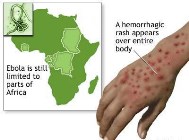New Type of Ebola Virus identified
 The American and Ugandan scientists have recently spotted a new species of the deadly Ebola virus.
The American and Ugandan scientists have recently spotted a new species of the deadly Ebola virus.
Back in 2007, wide region in western Uganda was badly affected from the new virus, named Bundibugyo ebolavirus. The scientists from the U.S. Centers for Disease Control and Prevention, Columbia University, the Uganda Virus Research Institute, and the Uganda Ministry of Health, informed that the new virus is different from all other known Ebola virus species, differing by more than 30 percent at the genetic level.
The recently developed "random-primed pyro-sequencing" method had to be employed by the scientists in order to determine the genetic signature of the new virus. The method helped them to quickly identify more than 70 percent of the virus genome, which then enabled fast development of a molecular detection assay that was used during the outbreak.
Moreover, the entire virus genome sequence was completed via the draft genetic sequence with the help of a traditional method and immediate confirmation that this was a new species of Ebola virus.
In an article published Nov. 21 in the journal PLoS Pathogens, the scientists said, “Current efforts to develop effective Ebola diagnostics, anti-virals and vaccines will need to factor in the distinct genetic makeup of this new species.”
Presently no vaccine or treatment has been found for the deadly Ebola infection in humans that has death rate of between 53 percent and 90 percent.